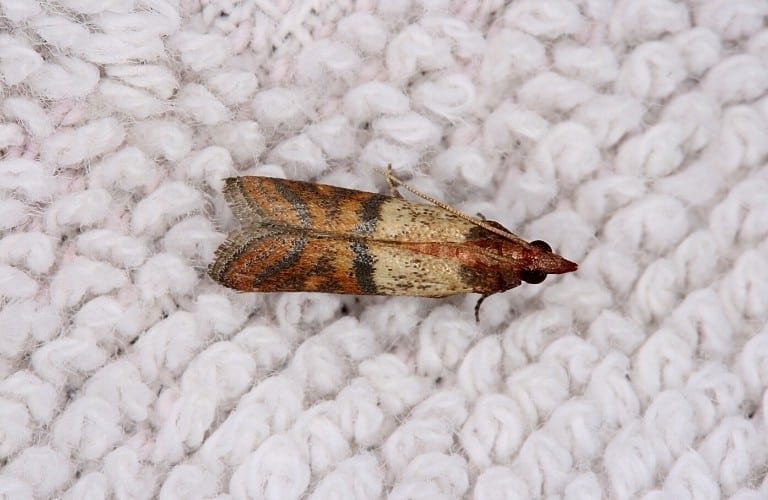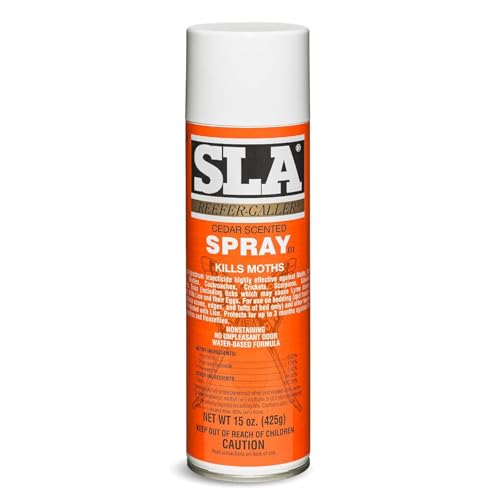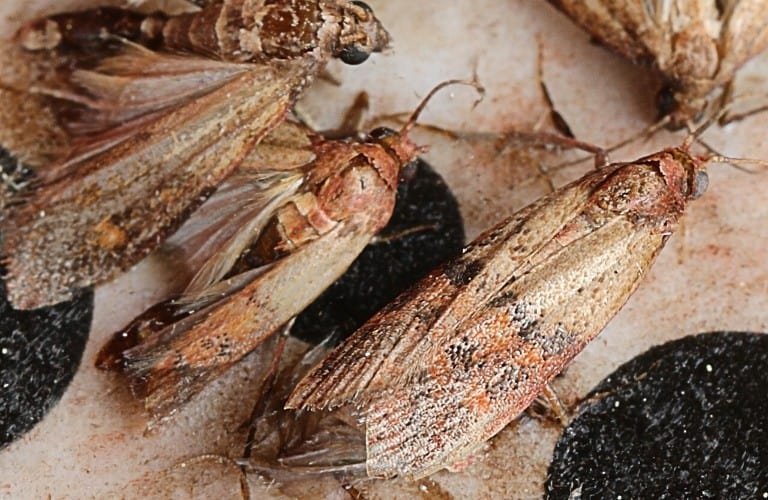Moths have diverse feeding habits that vary across their life stages and species. While some species of these fascinating creatures feed on natural fibers such as clothing and pantry goods, others play essential roles in the ecosystem by pollinating a wide variety of plant species.
Unfortunately, when moths find their way into our homes and eat our clothing or food they cause a nuisance. (find out where they come from here)
Understanding which moths eat and what moths eat can provide valuable insights into their behavior. This helps with preventing and treating infestations. You may be surprised to learn that not all moths eat clothing – and not all moths eat!
In this article, we will explore moths’ diets in great detail, and we’ll tell you how to discourage them from devouring your things.
If you’d like more helpful moth info, practical prevention guides, and elimination strategies that actually work, click here to access our full lineup of moth articles.
Moth Basics
Moths are fascinating creatures that are often overshadowed by their more colorful relatives, butterflies. In this section, we will explore the basics of moth biology, including their life cycles and different types of moths that can be found in nature.
Moth Life Cycle
Moths undergo a complex life cycle that consists of four stages:
- egg
- larva (caterpillar)
- pupa (cocoon)
- adult.
Adult moths lay their eggs on plants, which will be the larva’s food source when they hatch. The larvae, also known as caterpillars, then spend most of their time eating and growing until they reach their final size. At this point, they transform into a pupa by spinning a protective cocoon around themselves. Inside the cocoon, the moth undergoes metamorphosis and emerges as a fully-formed adult, ready to mate and continue the cycle.
Learn how long moths live here.
Types of Moths
There are around 160,000 known species of moths, and their habits and diets can vary significantly. Some of the more common types include:
- Clothes & Carpet Moths: These moths are notorious for their ability to infest and damage wool, silk, and other natural fabrics; they feed on the keratin proteins found in these materials. Their larvae are the ones responsible for causing the damage, as adult moths do not eat. These are typically either a webbing clothes moth (Tineola bisselliell) or a casemaking clothes moth (Tinea pellionella), coming from two distinct but similar families.
- Moths that feed on nectar: Many adult moths, like their butterfly counterparts, feed primarily on nectar and other sugary liquids using their proboscis. They often pollinate flowers while feeding, fulfilling an essential role in various ecosystems.
- Leafminer Moths: The larvae of these moths create tunnels or “mines” within leaves as they feed, which can lead to extensive damage to plants. Some species of leafminer moths are considered agricultural pests.
While there are thousands of species of moths, these examples illustrate the diversity of their feeding habits and the different roles they play in our ecosystems. Understanding the biology and behavior of these underappreciated insects can help us better appreciate their place in the world around us.
What Do Moths Eat?
Moths are diverse creatures with a wide range of dietary preferences. In this section, we’ll discuss the different dietary requirements of both adult moths and their caterpillar stage.
Adult Moth Diet
Adult moths primarily feed on nectar from flowers. Many moths have adapted their proboscis, a long, straw-like mouthpart, to reach the nectar of various flowering plants. Additionally, some moths are attracted to fruit juices and other sugary substances, such as saps oozing from trees.
It is important to note that not all adult moths eat; some species have no functional mouthparts, relying solely on the energy stored from their caterpillar stage to survive and reproduce.
Caterpillar (Larva) Diet
Caterpillar diets vary greatly depending on the species. Some caterpillars are generalists, feeding on a variety of plant species, while others are specialized, consuming only specific plants. Common food sources for caterpillars include:
- Leaves: The majority of caterpillars feed primarily on leaves from various plants, such as trees, shrubs, and herbs.
- Fruits and flowers: Some caterpillars prefer to consume plant parts other than leaves. For example, fruitworm moths have caterpillars that feed on fruits, while the larvae of flower moths consume flowers and buds.
- Animal-based materials: A few caterpillars have developed unique dietary preferences for materials such as animal hair, fur, or feathers. Case-bearing clothes moths (example) are one such species whose caterpillars feed on natural fibers, often causing damage to clothing and other textiles in our homes. This is highly relevant for any of you experiencing damage to your clothes or carpets!
Understanding the dietary requirements of moths is crucial for maintaining healthy populations of these essential pollinators and managing their impact on our daily lives.
Common Household Moths
What Do Clothes Moths Eat?
Clothes moths are a type of moth that can cause damage to natural fibers, including wool, silk, cotton, velvet, fur, leather, linen, and feathers. We usually find them in closets, drawers, and storage areas where clothing items are kept. Clothes moth larvae are responsible for the damage as they feed on the keratin proteins found in natural fibers, leaving behind holes and weakened fabric when they eat clothes.
Clothing is not the clothes moth’s cuisine of choice. In the wild, clothing moths look for animal carcasses or bits of nests to feed on.
What Do Pantry Moths Eat?
Pantry moths, also known as Indian meal moths or Plodia interpunctella, are another common type of household moth that infests stored food products. They typically target dry goods such as cereals, flour, grains, nuts, and pet food. Pantry moth infestations can lead to contaminated and unsuitable food for consumption.
We can prevent pantry moth larvae infestations by following proper storage practices for pantry items. This includes using air-tight containers, regularly checking the expiration dates of stored goods, and keeping the pantry clean and well-organized.
By being aware of the habits and preferences of these common household moths, we can take the necessary precautions to protect our homes and belongings from their potential damage.
What Do Carpet Moths Eat?
Carpet moth larvae are known to feed on carpets that have any amount of keratin in them.
If your carpet has any natural fibers in it, it could possibly attract carpet moths. You don’t have to worry about carpet moths at all if your carpet is totally synthetic.
It is important to recognize that damage attributed to clothes moths may in fact be caused by another group of insects adapted to digesting keratin— carpet beetles. Carpet beetles are very common in homes and buildings, and feed on most of the same materials as clothes moths. However, these pests are quite different in appearance. (For more information on carpet beetles, see )
Moths in Nature
Pollination
Moths play a significant role in the pollination of many plants. As they move from flower to flower, seeking nectar, moths unknowingly transfer pollen between them. This helps in the fertilization and reproduction of plant species. Interestingly, some plants have evolved to specifically attract moths for pollination purposes, such as the Luna moth, which does not have a mouth and cannot eat, but lives for about one week with the sole purpose of mating (source).
Role in Ecosystem
Moths serve as a vital component of the ecosystem. During their larval stage, they consume a variety of organic materials, such as fur, hair, paper, and dust, as well as plant matter (source). This helps in controlling the growth of plants and the recycling of nutrients within the environment. As a food source for many predators like birds, bats, and other insects, moths play a key role in maintaining the balance within the food chain.
Additionally, moths have evolved various adaptations to ensure their survival. Many moths possess intricate camouflage patterns that allow them to blend in with their surroundings, protecting them from potential predators. Some species are even capable of mimicking the appearance of other animals, such as wasps or bees, in order to deter predators from attacking them (source).
Moths are an essential part of the diverse ecosystem, contributing to pollination, nutrient cycling, and the food chain. With over 160,000 species of moths found throughout the world, their impact on our environment is immense and not to be underestimated (source).
Protecting Your Home
Protect Your Clothes From Clothes Moths
If feasible, put your clothing items in moth-proof garment bags (this 10-pack is washable and ideal for long-term storage) so that moths cannot get into them. Wash and dry your clothes thoroughly before storing them, especially if they’re made of natural fibers like cotton and wool.
Make sure that there are no holes in any of your bags. The moths will come back to feed if there is any way to get into the clothing.
Vacuum-sealed bags will also work fine as a preventative measure for moths.
It’s vital to maintain your clothing storage area. If you clean your closet only once or begin storing your clothes out in the open too soon after you first started to remedy the infestation, you may begin to see moths again.
You can also keep your light on in your closet and shake your clothing around occasionally. Moths won’t stay where there is either light or movement.
Wondering why mothballs aren’t mentioned here? They just aren’t considered safe to use. Instead, try these alternatives.
Keep your off-season clothing airtight. Storing clothing and fabrics in airtight plastic containers with tight-fitting lids (like these) can prevent moths from laying their eggs and feeding on the materials.
No products found.
No products found.
An additional natural preventive measure is to use essential oils, such as lavender oil. This oil can deter clothes moths and keep our garments safe. We can add a few drops of lavender oil to cotton balls and place them in drawers, closets, and storage containers. Other natural clothes moth solutions can be found here.
Protect Your Pantry From Pantry Moths
When it comes to our pantry, we should make sure to store dry foods, including grains, nuts, flours, spices, and chocolate, in sealed containers. This step will help prevent pantry moths from infesting and spoiling our food.
Treatment Options
If we find ourselves dealing with a moth infestation, there are several treatment options to consider to help us get rid of them. Below are some methods for addressing the issue.
Be sure to check our complete guide “How To Get Rid of Moths” for additional prevention tips and a full list of effective products to tackle your moth problem.
Stop Clothes Moths From Eating Clothing
If you’ve noticed holes in your clothing, don’t despair. There are effective tactics that you can use to stop moths from eating your clothes. While we’ve included a brief summary below, this section isn’t comprehensive.
For a more complete review of how to stop clothes moths from eating your clothing, check out our complete guide here.
Make Sure That You Have Clothes Moths
Clothes moths are not the only bugs that eat clothing. Even if you find a moth on your clothing, if it is longer than a centimeter, it is not likely a clothes moth.
Also, clothes moths will likely be a faint gray or yellow color. It’s important to know what bug you’re dealing with so you can tailor your treatment plan accordingly.
Clean Up Your Space
Once you are reasonably sure that you’re dealing with clothes moths, then break out the vacuum cleaner and get busy cleaning. Vacuum your entire floor to suck up any moth larvae that may have been laid there.
Regularly vacuuming and cleaning floors, carpets, and upholstered furniture is an effective way to keep them at bay. It’s crucial to maintain a clean and tidy environment, as it helps deter the moth population from growing.
Get Rid of Infested Clothing
Throw away all clothing that is damaged beyond repair – if it is infested, you want it out of your house.
Even if you have to throw away some of your favorite pieces, remember that this needs to be done in order to get rid of the infestation.
Kill Larvae by Washing Your Clothes
Larvae are invisible to the naked eye, so there is no way to know which pieces are infested unless they’re clearly damaged – but you’ve already thrown away that clothing by now!
For remaining clothes, wash your articles at the hottest setting you can manage without ruining them.
If you fear that you’ll ruin some of your clothes by washing them at high temperatures, you can have them professionally dry cleaned instead.
Stop Pantry Moths From Eating Pantry Food
If the moths have already taken over your kitchen and pantry, you can take some steps to rid yourself of those pesky bugs.
The following section will tell you what to do step by step:
- Begin by getting rid of all of your dry food. This is necessary because moths lay eggs in the food that they eat. If you have a moth infestation, there is a good chance that they have gotten into most of your dry foods. Throw it all in the garbage.
- Clean up your pantry. Moths, in general, are very good at hiding and can fit into the smallest spaces. Vacuum and then wipe down your shelves, every corner, the floor, and any goods that you choose to leave in the pantry. Use soap and water for all surfaces.
- Put out some sticky traps. Not just any sticky trap will do. Use only moth traps made for pantry moths (like this six-pack of pheromone traps). Change out the traps as they become full. These moth traps attract and capture adult moths by mimicking the scent of their mates. They can be an effective way to reduce the moth population and monitor the level of infestation.
Stop Moths From Eating Carpet
To stop moths from feeding on your carpet, the solution is simple. Purchase a moth spray for carpets and follow the instructions on the can.
Most sprays are designed to be sprayed on the outer edges of carpets. Over time, the spray will kill any moths that try to eat your carpet.
Professional Pest Control
If the infestation persists or is widespread, it may be time to consider hiring a professional pest control service. They have the experience and expertise to eliminate the infestation and provide guidance on preventing future occurrences.
A simple Internet search for moth extermination services in your area will help you find a pest control company that can help.
With these preventive measures and treatment options in mind, we can effectively protect our home against moths and the damage they can cause.
Frequently Asked Questions
Do moths consume fibers from clothing?
Yes, some species of moths are known to consume fibers from clothing, particularly those made of natural materials like wool, silk, and fur. The larvae of clothes moths are the ones that cause damage, as they feed on the protein keratin found in animal-based fibers.
What is the primary diet of moths?
The primary diet of moths varies depending on the species and their stage of life. In their larval stage, moths eat plant materials, fibers, and other organic materials. As adults, some moths do not eat at all, while others feed on nectar from flowers or other sweet substances like fruit juices.
Are moths known to eat household items?
Yes, moths can consume various household items, particularly when they invade pantries. They can be found munching on grains, cereals, nuts, and even pet food. In addition, some species of moths, like clothes moths, eat fabrics and textiles in the home.
Do moths consume plant materials?
Many moth species consume plant materials, particularly during their larval stage. Caterpillars of various moth species can be found feeding on leaves, stems, and other plant parts, sometimes causing significant damage to crops and gardens.
Can moths eat fruit and other sweet substances?
Yes, some species of moths enjoy feeding on fruit and other sweet substances. Adult moths are often attracted to rotting fruits, as these provide an easy source of nourishment when other food sources may not be readily available.
Do moths have a preference for specific materials?
Moths’ preferences for specific materials depend on the species. Some moth species have evolved to feed on very specific plant species, while others are generalists and consume a variety of materials. In the context of household items, clothes moths are known to prefer natural fibers like wool, silk, and fur.







